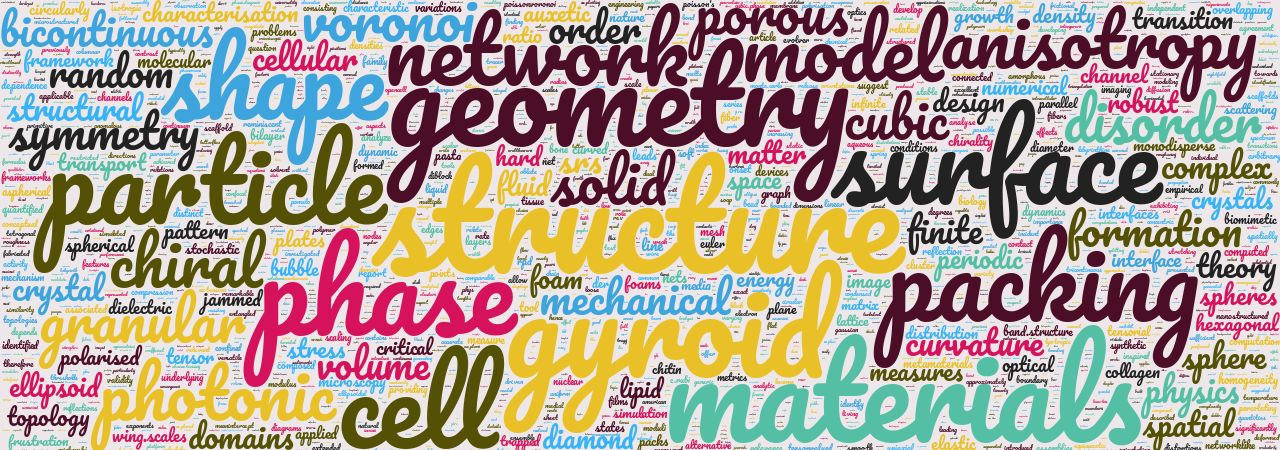Research
Materials Geometry
“Where there is matter, there is geometry” (Johannes Kepler, 1602)
I often refer to my research field as “Materials geometry”, that is, the materials science, soft matter physics and statistical mechanics of complex materials and biological tissues, addressed through the goggles of geometry.
Broadly speaking, my research questions fall within the following themes, with plenty of overlap between them
- Soft matter self-assembly, particularly bicontinuous and network phases
- Structure formation in soft matter and biological materials
- Optics of nanofabricated and biophotonic Gyroid materials
- Material design and structure-property relationships
- Biophysics, medical physics and biomaterials applications
- Disordered materials and packing problems
- Structure metrics for amorphous media
- Non-equilibrium driven systems, transport processes and dynamics
I address these questions using the tools of statistical, theoretical and computational physics, applied mathematics and computational materials science, combined with methods from stochastic and integral geometry, differential geometry and computational geometry (Click here for ‘My methods section’). I enjoy interdisciplinary work, in particular in relation to 3D tomographic imaging and 3D free-form fabrication and nanofabrication and with biological scientists.

A word cloud of my journal article titles and abstracts and conference talk titles, generated using wordclouds.com (some editing of generic words was applied).
Most of that research addresses materials with a complex spatial micro- or nanostructure. In terms of these structures -sometimes ordered sometimes not- I typically address one of four questions:
- Formation: How and why does structure form? This includes the formation by equilibrium self-assembly and out-of-equilibrium pattern formation, the dynamics of their formation processes, the emergence of both complex ordered and complex disordered structures, and the genesis of structure in biology. A recurring theme through my career has been the question why negatively curved geometries occur, in chemistry, biology and physics and the question as to how you can get complex structure from simple ingredients.
- Characterisation: How do we quantitatively describe complex geometries? Physics is a quantitative discipline and tools (“structure metrics”) are needed that capture some core properties of shape in numbers. I look at the questions “What’s a good structure metric for a given system?” from what makes sense in terms of what we know about the physics of a system, as well as from what mathematical morphology knows about the structure at hand and from what can be measured in a laboratory.
- Functional properties: Which physical properties emerge from a complex geometry? Under the broad heading of structure-function relationships, the nano- or microstructure of a material can determine the properties of a material, incl optical, transport, mechanical, rheology, etc. Using computational materials science, I endeavour to entangle this relationship … always bearing in mind that some properties are caused by structure, others by the constituent material itself.
- Engineering design applications: How can we use nature’s designs for custom-fabrication, or even improve them? One of the fun aspects of geometry is to think about the possibilities. Not only does 3D printing (including nanofabrication at the very small scale) allow us to replicate structures built by nature. It also lets us built those geometries of the imagination, that maybe came out of enumerating a class of structures or optimising a geometry with respect to a particular property. Work that I have done in this space includes in particular the replication of gyroid geometries found in butterflies and thinking about their multiply intergrown counterparts.
